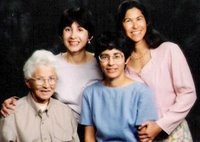In January of this year, completely out of the blue, I received an invitation to an Ikehara Family Reunion. “What? Who is this guy?” was my immediate reaction, but in the same instant I realized that I knew the person who had sent the invitation, if only by last name (Shimabukuro was the married name of my father’s cousin, whom I had met as a child because she and her family lived in a nearby town).
My father was one of eight children, and I knew my aunts and uncles fairly well: Gus, Archie, Dot, Helen, Doris, Harriet, and Katherine (these are their English names). I had also met all 21 of my first cousins because many of them lived either on Kauai or in Honolulu. But my grandfather had a brother who also immigrated to Hawaii early in the 20th century, and it was this side of the family that was virtually unknown to me.
I hadn’t seen any of my Honolulu or California relatives in decades, and I knew I had never met most of my grandfather’s brother’s descendants, so I decided to attend. In fact, I was one of almost 60 people who travelled to Reno, Nevada, for the reunion activities scheduled on Friday and Saturday, June 15th and 16th.
On Friday evening, we gathered for a pupu party in the Mandalay Room of the Circus Circus Hotel. This was an informal event where we introduced ourselves to those we’d never met, or re-acquainted ourselves with family members we hadn’t seen in years. George also put together a slide show, with favorite photos contributed by everyone (the ones I chose are not exactly representative, but some of them depict significant events in the lives of my parents and siblings).
Saturday evening was the formal reunion dinner in the Bordeaux Room of the El Dorado Hotel. Although I’m still on a restricted diet due to a dental procedure last month, I discovered, much to my delight, that I could eat everything I wanted. And the food, including the desserts, was excellent! I brought my digital camera with me to this event, but it does not function well when it needs the flash, and the photos I took were uniformly bad. I discarded all but the three which I’ve posted below.
Mike Shironaka took this photo. I’m talking to my cousin Ann Mashita. She looks seriously concerned about something, but I remember us having a light-hearted conversation! Ann was there with her son Tony.
I took this photo of the younger children who attended. I’m listing their names as Ally, Hana, Samantha, Kai, and Alexia but I’m probably wrong about some or all of them.
My uncle Henry and Aunt Kikue, my father’s youngest sister, have been married for many many years. Ki was named by my parents as my guardian while I was attending a boarding high school in Honolulu.
So, who are we? In the first mailing, George had solicited basic genealogical information from everyone on the list of family members, and from the responses, he compiled our personal biographies into a family tree. This document is by no means finalized, but with additional historical research into people, places, and dates, we’re hoping eventually to have a fairly comprehensive record of our family’s history in the US.
When I first looked at the list of names we all received, I began to wonder how many of us, the descendants of the two brothers, there are. I learned that Kama was the older brother who emigrated from Okinawa to Hawaii in 1907, followed by his younger brother, my grandfather Gashin, who arrived in 1915. Kama had four children and my grandfather eight, as I mentioned earlier. Kama and Gashin are the Issei, the first generation of Americans. In Kama’s family, there are four children (two boys and two girls) counted in the second generation, fifteen (six boys and nine girls) in the third generation, eighteen (ten boys and eight girls) in the fourth generation, and one in the fifth generation (one girl). In Gashin’s family, there are eight children (three boys and five girls) in the second generation, twenty-four (fourteen boys and ten girls) in the third generation, twenty-two (twelve boys and ten girls) in the fourth generation, and three (one boy and two girls) in the fifth generation. The second generation are called the Nisei, the third the Sansei, the fourth the Yonsei, and the fifth, as I learned recently from Wikipedia, the Gosei.
Toward the end of the evening on Saturday, we had a group photograph taken, and when I receive my copy, I know it will become one of my treasures. Certainly, my vivid memories of this first Ikehara Family Reunion will not soon fade.

